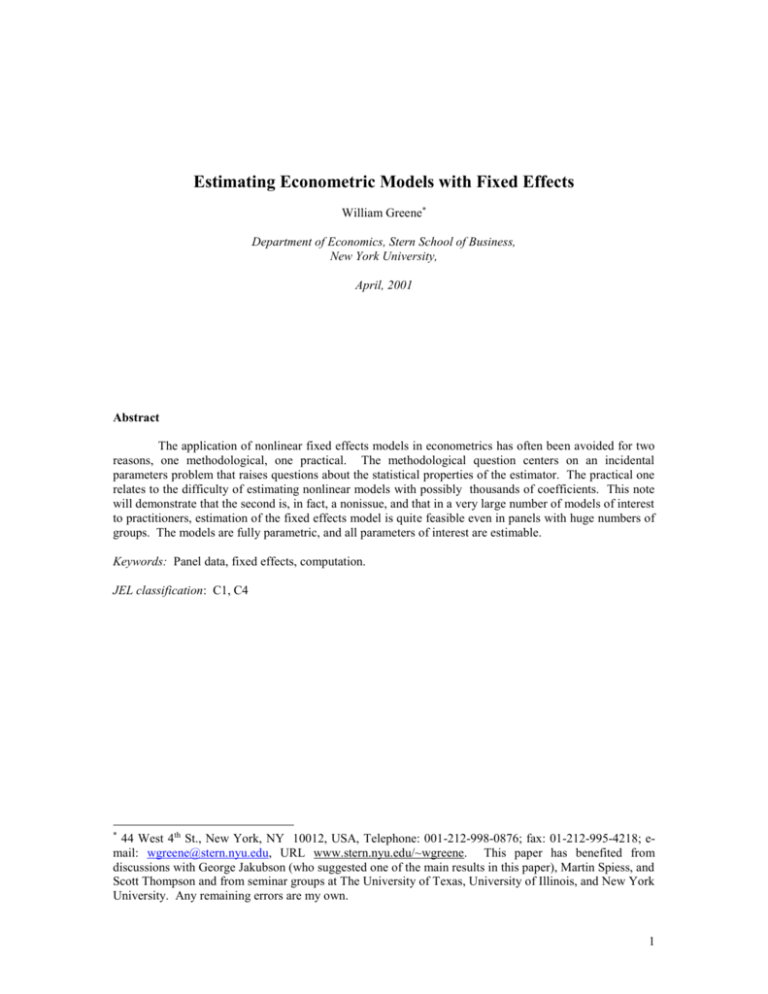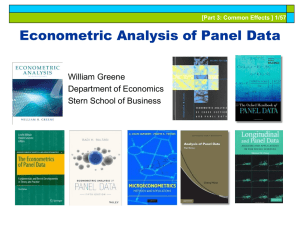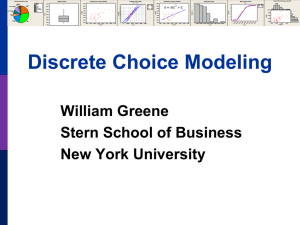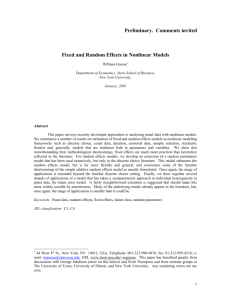Estimating Econometric Models with Fixed Effects
advertisement

Estimating Econometric Models with Fixed Effects
William Greene*
Department of Economics, Stern School of Business,
New York University,
April, 2001
Abstract
The application of nonlinear fixed effects models in econometrics has often been avoided for two
reasons, one methodological, one practical. The methodological question centers on an incidental
parameters problem that raises questions about the statistical properties of the estimator. The practical one
relates to the difficulty of estimating nonlinear models with possibly thousands of coefficients. This note
will demonstrate that the second is, in fact, a nonissue, and that in a very large number of models of interest
to practitioners, estimation of the fixed effects model is quite feasible even in panels with huge numbers of
groups. The models are fully parametric, and all parameters of interest are estimable.
Keywords: Panel data, fixed effects, computation.
JEL classification: C1, C4
*
44 West 4th St., New York, NY 10012, USA, Telephone: 001-212-998-0876; fax: 01-212-995-4218; email: wgreene@stern.nyu.edu, URL www.stern.nyu.edu/~wgreene. This paper has benefited from
discussions with George Jakubson (who suggested one of the main results in this paper), Martin Spiess, and
Scott Thompson and from seminar groups at The University of Texas, University of Illinois, and New York
University. Any remaining errors are my own.
1
1. Introduction
The fixed effects model is a useful specification for accommodating individual
heterogeneity in panel data. But, it has been problematic for two reasons. In most cases, the
estimator is inconsistent owing to the incidental parameters problem. How serious this problem
is in practical terms remains to be established - there is only a very small amount of received
evidence - but the theoretical result is unambiguous. A second problem is purely practical. With
current technology, the computation of the model parameters and appropriate standard errors,
with all its nuisance parameters, appears to be impractical. This note focuses on the second of
these, and shows that in a large number of interesting cases, the difficulty is only apparent. We
will focus on a single result, computation of the estimator, and rely on some well known
algebraic results to establish it. No formal statistical results are derived here or suggested with
Monte Carlo results, as in general, the results are already known. The one statistical question
noted above is left for further research.
The paper proceeds as follows. In Section 2, the general modeling framework is
presented, departing from the linear model to more complicated specifications. The formal
results for the estimator and computational procedures for obtaining appropriate standard errors
are presented in Section 3. Section 4 suggests two possible new applications. Conclusions are
drawn in Section 5.
2. Models with Fixed Effects
The linear regression model with fixed effects is
yit = xit + i + t + it, t = 1,...,T(i), i = 1,...,N,
E[it|xi1,xi2,...,xiT(i)]
= 0,
Var[it|xi1,xi2,...,xiT(i)]
= 2.
We have assumed the strictly exogenous regressors case in the conditional moments, [see
Woolridge (1995)]. We have not assumed equal sized groups in the panel. The vector is a set
of parameters of primary interest, i is the group specific heterogeneity. We have included time
specific effects but, they are only tangential in what follows. Since the number of periods is
usually fairly small, these can usually be accommodated simply by adding a set of time specific
dummy variables to the model. Our interest here is in the case in which N is too large to do
likewise for the group effects. For example in analyzing census based data sets, N might number
in the tens of thousands. The analysis of two way models, both fixed and random effects, has
been well worked out in the linear case. [See, e.g., Baltagi (1995) and Baltagi, et al. (2001).] A
full extension to the nonlinear models considered in this paper remains for further research.
The parameters of the linear model with fixed individual effects can be estimated by the
'least squares dummy variable' (LSDV) or 'within groups' estimator, which we denote bLSDV. This
is computed by least squares regression of yit* = (yit - y i . ) on the same transformation of xit where
the averages are group specific means. The individual specific dummy variable coefficients can
be estimated using group specific averages of residuals. [See, e.g., Greene (2000, Chapter 14).]
The slope parameters can also be estimated using simple first differences. Under the
assumptions, bLSDV is a consistent estimator of . However, the individual effects, i, are each
estimated with the T(i) group specific observations. Since T(i) might be small, and is, moreover,
fixed, the estimator, ai,LSDV, is inconsistent. But, the inconsistency of ai,LSDV, is not transmitted to
2
bLSDV because y i. is a sufficient statistic. The LSDV estimator bLSDV is not a function of ai,LSDV.
There are a few nonlinear models in which a like result appears.
We will define a nonlinear model by the density for an observed random variable, yit,
f(yit | xi1,xi2,...,xiT(i)) = g(yit, xit + i, )
where is a vector of ancillary parameters such as a scale parameter, an overdispersion parameter
in the Poisson model or the threshold parameters in an ordered probit model. We have narrowed
our focus to linear index function models. For the present, we also rule out dynamic effects; yi,t-1
does not appear on the right hand side of the equation. [See, e.g., Arellano and Bond (1991),
Arellano and Bover (1995), Ahn and Schmidt (1995), Orme (1999), Heckman and MaCurdy
(1980)]. However, it does appear that extension of the fixed effects model to dynamic models
may well be practical. This, and multiple equation models, such as VAR's are left for later
extensions. [See Holtz-Eakin (1988) and Holtz-Eakin, Newey and Rosen (1988, 1989).] Lastly,
note that only the current data appear directly in the density for the current yit. We will also be
limiting attention to parametric approaches to modeling. The density is assumed to be fully
defined. This makes maximum likelihood the estimator of choice.
The likelihood function for a sample of N observations is
L = iN1 Tt(1i ) g ( yit , ' x it i , ).
The likelihood equations,
log L
0,
log L
log L
0,
0, i 1,..., N ,
i
do not have explicit solutions for the parameter estimates in terms of the data and must, therefore,
be solved iteratively. In principle, maximization can proceed simply by creating and including a
complete set of dummy variables in the model. But, at some point, this approach becomes
unusable with current technology. We are interested in a method that would accommodate a
panel with, say, 50,000 groups, which would mandate estimating a total of 50,000 + K + K
parameters. What makes this impractical is a second derivatives matrix (or some approximation
to it) with 50,000 rows and columns. But, that consideration is misleading, a proposition we will
return to presently.
The proliferation of parameters is a practical shortcoming of the fixed effects model. The
'incidental parameters problem' is a methodoligical issue. If and were known, then, the
solution for i would be based on only the T(i) observations for group i (see below for an
application). This implies that the asymptotic variance for ai is O[1/T(i)] and, since T(i) is fixed,
ai is inconsistent. In fact, is not known; in general in nonlinear settings, the estimator will be a
function of the estimator of i, ai,ML. Therefore bML, MLE of is a function of a random variable
which does not converge to a constant as N , so neither does bML. There is a small sample
bias as well. The example is unrealistic, but Hsiao (1993, 1996) shows that in a binary logit
model with a single regressor that is a dummy variable and a panel in which T(i) = 2 for all
groups, the small sample bias is +100%. No general results exist for the small sample bias in
more realistic settings. Heckman (1981) found in a Monte Carlo study of a probit model that the
bias of the slope estimator in a fixed effects model was toward zero and on the order of 10%
when T(i) = 8 and N = 100. On this basis, it is often noted that in samples at least this large, the
small sample bias is probably not too severe. In many microeconometric applications, T(i) is
considerably larger than this, so for practical purposes, there is good cause for optimism.
3
3. Computation of the Fixed Effects Estimator
In the linear case, regression using group mean deviations sweeps out the fixed effects.
The slope estimator is not a function of the fixed effects which implies that it (unlike the
estimator of the fixed effect) is consistent. There are a few analogous cases of nonlinear models
that have been identified in the literature. Among them are the binomial logit model,
g(yit, xit + i) = [(2yit - 1)(xit + i)]
where (.) is the cdf for the logistic distribution [see Chamberlain (1980)]. In this case, tyit is a
sufficient statistic, and estimation in terms of the conditional density provides a consistent
estimator of . [See Greene (2000) for discussion.] Three other models which have this property
are the Poisson and negative binomial regressions [See Hausman, Hall, and Griliches (1984)] and
the exponential regression model.
g(yit, xit + i) = (1/it)exp(-yit/it), it = exp(xit + i), yit 0.
[See Munkin and Trivedi (2000) and Greene (2001).] In these models, there is a solution to the
likelihood equation for that is not a function of i. Consider the Poisson regression model with
fixed effects - the result for the exponential model is essentially the same - for which
log g(yit, , xit + i) = -it + yit log it - log yit!
where it = exp(xit + i) = exp(i)exp(xit). Then,
log L
=
i1 t 1
N
T (i )
exp(i ) exp(' xit ) yit (' xit i ) log yit !
The likelihood equation for i, logL/i = 0, implies a solution
t 1
T (i )
exp(i) =
yit
T (i )
exp( ' xit )
t 1
.
Thus, the maximum likelihood estimator of is not a function of i. There are other models with
loglinear conditional mean functions, however these are too few and specialized to serve as the
benchmark case for a modeling framework. In the vast majority of cases of interest to
practitioners, including those based on transformations of normally distributed variables such as
the probit and tobit models, this method will be unusable.
Heckman and MaCurdy (1980) suggested a 'zig-zag' sort of approach to maximization of
the log likelihood function, dummy variable coefficients and all. Consider the probit model. For
known set of fixed effect coefficients, = (1,...,N), estimation of is straightforward. The log
likelihood conditioned on these values (denoted ai), would be
log L|a1,...,aN =
i 1 t 1
N
T (i )
log [(2 yit 1 ' xit ai )
4
This can be treated as a cross section estimation problem since with known , there is no
connection between observations even within a group. With given estimate of (denoted b) the
conditional log likelihood function for each i,
log Li|b =
t 1
T (i )
log (2 yit 1)( z it i )
where zit = bxit is now a known function. Maximizing this function is straightforward (if
tedious, since it must be done for each i). Heckman and MaCurdy suggested iterating back and
forth between these two estimators until convergence is achieved. There is no guarantee that this
back and forth procedure will converge to the true maximum of the log likelihood function
because the Hessian is not block diagonal. Whether either estimator is even consistent in the
dimension of N (that is, of ) depends on the initial estimator being consistent, and it is unclear
how one should obtain that consistent initial estimator. There is no maximum likelihood
estimator for i for any group in which the dependent variable is all 1s or all 0s, - the likelihood
equation for log Li has no solution if there is no within group variation in yit. This feature of the
model carries over to the tobit and binomial logit models, as the authors noted. In the Poisson
and negative binomial models, any group which has yit = 0 for all t contributes a 0 to the log
likelihood function so its group specific effect is not identified either. Finally, irrespective of its
probability limit, the estimated covariance matrix for the estimator of will be too small, again
because the Hessian is not block diagonal. The estimator at the step does not obtain the correct
submatrix of the information matrix.
Many of the models we have studied involve an ancillary parameter vector, . No
generality is gained by treating separately from , so at this point, we will simply group them in
the single parameter vector = [,]. Denote the gradient of the log likelihood by
log g ( y it , , x it , i )
(a K1 vector)
g
=
log L
=
gi
=
log L
=
i
g
= [g1, ... , gN] (an N1 vector)
g
= [g, g] (a (K+N)1 vector).
i1 t 1
N
t 1
T (i )
T (i )
log g ( yit , , x it , i )
(a scalar)
i
The full (K+N) (K+N) Hessian is
H
H h 1 h 2
h ' h
0
11
1
= h 2 ' 0 h22
h N ' 0
0
H
=
h N
0
0
0
0 h NN
where
i1 t 1
N
T (i )
2 log g ( y it , , x it , i )
(a K K matrix)
'
5
hi
=
t 1
2 log g ( yit , , x it , i )
(N K 1 vectors)
i
hii
=
t 1
2 log g ( y it , , x it , i )
T (i )
T (i )
(N scalars).
i 2
Newton's method of maximizing the log likelihood produces the iteration
k
-1
= - H k 1 gk-1 =
+
k 1
k 1
where subscript 'k' indicates the updated value and 'k-1' indicates a computation at the current
value. Let H denote the upper left KK submatrix of H-1 and define the NN matrix H and
KN H likewise. Isolating , then, we have the iteration
k
=
k-1
- [H g + H g]k-1 =
k-1
+
Using the partitioned inverse formula [e.g., Greene (2000, equation 2-74)], we have
H
-1
= [H - H H -1
H] .
The fact that H is diagonal makes this computation simple. Collecting the terms,
H
N
= H i 1
1
hii
h i h i '
1
Thus, the upper left part of the inverse of the Hessian can be computed by summation of vectors
and matrices of order K. We also require H. Once again using the partitioned inverse formula,
this would be
H
= -H H H -1
As before, the diagonality of H makes this straightforward. Combining terms, we find
=
- H ( g - H H -1
g)
N
= - H i 1
1
hii
1
h i h i '
k 1
g
g iN1 i h i
hii
k 1
6
Turning now to the update for , we use the same results for the partitioned matrices. Thus,
= - [H g + H g]k-1.
Using Greene's (2-74) once again, we have
H
-1
= H -1
(I + HH H H )
H
-1
= -H H H -1
= - H HH
Therefore,
-1
-1
-1
-1
= - H -1
(I + HH H H )g + H (I + HH H H )H H g.
= - H -1
(g + H).
Since H is diagonal,
i
= -
1
gi h i ' .
hii
Neither update vector requires storage or inversion of a (K+N)(K+N) matrix; each is a
function of sums of scalars and K1 vectors of first derivatives and mixed second derivatives.1
The practical implication is that calculation of fixed effects models is a computation only of order
K. Storage requirements for and are linear in N, not quadratic. Even for huge panels of
tens of thousands of units, this is well within the capacity of even modest desktop computers. In
experiments, we have found this method effective for probit models with 10,000 effects. (An
analyst using this procedure for a tobit model reported success with nearly 15,000 coefficients.)
(The amount of computation is not particularly large either, though with the current vintage of 2+
GFLOP processors, computation time for econometric estimation problems is usually not an
issue.)
The estimator of the asymptotic covariance matrix for the MLE of is -H, the upper left
submatrix of -H-1. This is a sum of K K matrices, and will be of the form of a moment matrix
which is easily computed (see the application below). Thus, the asymptotic covariance matrix for
the estimated coefficient vector is easily obtained in spite of the size of the problem. The
asymptotic covariance matrix of a is
-1
-1
-1
-1
-1
-1
-1
-(H - H H -1
H) = - H - H H { H - H H H} H H .
It is (presumably) not possible to store the asymptotic covariance matrix for the fixed effects
estimators (unless there are relatively few of them). But, by expanding the summations where
needed and exploiting the diagonality of H, we find that the individual terms are
1
The iteration for the slope estimator is suggested in the context of the binary logit model by Chamberlain
(1980, page 227). A formal derivation of and was presented by George Jakubson of Cornell
University in an undated memo, "Fixed Effects (Maximum Likelihood) in Nonlinear Models."
7
1
1 1 1
N
1
h i ' H 1' i 1
h i h i ' h j
Asy. Cov ai , a j 1(i j )
hii hii h jj
hii
1(i j ) h i
'H
hii
hii
h j
h jj
.
Once again, the only matrix to be inverted is K K, not NN (and, it is already in hand) so this can
be computed by summation. It involves only K1 vectors and repeated use of the same KK
inverse matrix. Likewise, the asymptotic covariance matrix of the slopes and the constant terms can
be arranged in a computationally feasible format;
Asy.Cov[c,a] = Asy.Var[c] H H -1
.
This involves NN and KN matrices, but it is simplifies to
h i
hii
Asy.Cov[c,ai] = Asy.Var[c]
4. Applications
To illustrate the preceding, we examine two applications, the binomial probit (and logit)
model(s) and a sample selection model. (With trivial modification, the first of these will extend
to many other models, as shown below.)2
4.1. Binary Choice and Simple Index Function Models
For a binomial probit model with dependent variable zit,
g(zit, xit + i) = [(2zit - 1)(xit + i)] = (qit rit) = (ait)
and
log L
=
i 1 t 1
N
T (i )
log [qit ' xit i ) ].
Define the first and second derivatives of log g(zit, xit + i) with respect to (xit + i) as
(ait )
(ait )
it
= qit
it
= -ait it - it2, -1 < it < 0.
The derivatives of the log likelihood for the probit model are
2
We assume in the following that none of the groups have yit always equal to 1 or 0. In practice, one
would have to determine this as part of the estimation process. It should be noted for the practitioner that
this condition is not trivially obvious during estimation. The usual criteria for convergence, such as small
will appear to be met while the associated i is still finite even in the presence of degenerate groups.
8
gi
=
g
=
hii
=
hi
=
H
=
=
T (i )
t 1
qit it ,
N
T (i )
i 1
t 1
T (i )
t1
T (i )
t1
qit it xit ,
it ,
it xit ,
N
T (i )
i 1
t 1
it xit xit ' .
For convenience, let
i
T (i )
t1
it
and
~
xi
= hi / hii =
T (i )
it xit /
t 1
T (i )
t 1
it
~
Note that x i is a weighted within group mean of the regressor vectors.
The update vectors and computation of the slope and group effect estimates follows the
template given earlier. After a bit of manipulation, we find the asymptotic covariance matrix for
the slope parameters is
Asy.Var[bMLE] = [-H]
-1-
~
~
N T (i )
= - i 1 t 1 it xit xi xit xi
1
The resemblance to the 'within' moment matrix from the analysis of variance context is notable
and convenient. Inserting the parts and collecting terms produces
~
~
N T (i )
= i 1 t 1 it xit xi xit xi
1
N
i 1
~
T (i )
q
x
x
i
it
it
it
t 1
and
i =
T (i )
t 1
qit it / i
~
+ xi '
Denote the matrix in the preceding as
V
= -[H]-1 = Asy.Var[bMLE].
Then,
Asy.Cov[ai,aj] =
~
~
1(i j )
+ xi ' V x j
i
=
1(i j )
+ sij
i
Finally,
9
~
= -V x i
Asy.Cov[bMLE,ai]
Each of these involves a moderate amount of computation, but can easily be obtained with
existing software and, most important for our purposes, involves computations that are linear in N
and K. We note as well that the preceding extends directly to any other simple index function
model, such as the binomial logit model [change derivatives it to (1- it) and it to -it(1 - it)
where it is the logit CDF] and the Poisson regression model [replace it with (yit - mit) and it
with -mit where mit = exp(xit + i)]. Extension to models that involve ancillary parameters, such
as the tobit model, are a bit more complicated, but not excessively so.
The preceding provides the estimator and asymptotic variances for all estimated
parameters in the model. For inference purposes, note that the unconditional log likelihood
function is computed. Thus, a test for homogeneity is straightforward using the likelihood ratio
test. Finally, one would normally want to compute marginal effects for the estimated probit
model. The conditional mean in the model is
E[zit | xit] = (xit + i)
so the slopes in the model are
E[ zit | xit ]
' xit i ) = .
xit
In many applications, marginal effects are computed at the means of the data. The heterogeneity
in the fixed effects presents a complication. Using the sample mean of the fixed effects
estimators, the estimator would be
Est.
_
_
E[ zit | xit ]
b b ' x a) = d.
xit
In order to compute the appropriate asymptotic standard errors for these estimates, we need the
asymptotic covariance matrix for the estimated parameters. The asymptotic covariance matrix for
the slope estimator is already in hand, so what remains is Asy.Cov[b, a ] and Asy.Var[ a ]. For
the former,
AsyCov[b, a ] =
~
1 N
V
x
i 1 i V x
N
while, by summation, we obtain
Asy.Var[ a ]
=
1 N 1
+
N 2 i 1 i
N
N
i 1
j 1
sij
These would be assembled in a (K+1)(K+1) matrix, say V*. The asymptotic covariance matrix
for the estimated marginal effects would be
Asy.Var[] = GV*G
10
where the K and one columns of G are contained in
_
_
_
_
_
= ' x ) I ' x ) x'
G
|
_
_
' x )
These results extend to any simple index function model including several discrete choice
and limited dependent variable models. Likewise, the derivation for the marginal effects is
actually generic, and extends to any model in which the conditional mean function is of the form
m(xit + i).
4.2. A Sample Selection Model
Several researchers have studied the application of Heckman's (1979) sample selection
model to panel data sets. [See Greene (2001) for a survey.] A formal treatment with fixed effects
remains to be proposed. We formulate the model as follows:
(1) Probit selection equation:
= 1(xit + i + uit) > 0, E[uit] = 0, Var[uit] = 1.
zit
(2) Regression equation - data observed when zit = 1:
= wit + i + it, E[it] = 0, Var[it] = 2, Cov[it,uit] = .
yit
The full log likelihood function for this model is
log L =
N
T (i )
i 1
t 1, zit 0
N
T (i )
i 1
t 1, zit 1
log ' xit i +
1 ( y ' w it i ) / + ' xit i
log ' xit 1 it
1 2
This involves all K + K + 2N + 2 parameters. In principle, one could proceed in a fashion
similar to that shown earlier, though with two full sets of fixed effects, the complication grows
rapidly. We propose, instead, a two step approach which bears some resemblance to Heckman's
method for fitting this model by two step regression. At step 1, estimate the parameters of the
probit model. At step 2, we estimate the remaining parameters, conditionally on these first step
estimates. Each step uses the method of Section 3. This is the standard two step maximum
likelihood estimator discussed in Murphy and Topel (1985) and Greene (2000, Chapter 4). The
second step standard errors would then be corrected for the use of the stochastic parameter
estimates carried in from the first step. We return to this consideration below.
The estimation of the parameters of the probit model, and i is discussed in the
preceding section. For the second step, it is convenient to reparameterize the log likelihood
function. Let = (1/), i = i/, = 1/, and = /
simplifications, the log likelihood function reduces to
log L =
N
T (i )
i 1
t 1
N
T (i )
i 1
t 1, zit 1
1 2 and let dit = xit + i. With these
log (qit dit ) +
log log 1 2 (yit ' wit i ) dit
11
For purposes of the conditional estimator, we treat dit as known. Thus, only the second half of the
function need be considered. We now apply the procedure of Section 3. This provides the full
set of estimates for the entire model. What remains is correction of the standard errors at the
second step. The algebra at this step appears to be intractable, even with all the simplifications
made thus far. We have had some success with bootstrapping (where i = 1,...,N is the sample).
Further results await additional research.
5. Conclusions
The literature has treated the selection of the random and fixed effects models as a
Hobson's choice. The computational difficulties and the inconsistency caused by the small T(i)
problem have made the fixed effects model unattractive. The practical issues may well be moot,
but the methodological problem remains. Still, there is a compelling virtue of the fixed effects
model as compared to the random effects model. The assumption of zero correlation between
latent heterogeneity and included observed characteristics that is necessary in the random effects
model is particularly restrictive.
With the exceptions noted earlier the fixed effects estimator has seen relatively little use in
nonlinear models. The methodological issue noted above has been a major obstacle, though
convincing results remain to be established. Hsiao's example is striking but quite unrealistic.
Heckman's example based on T(i) = 8 gives cause for greater optimism, but more research on the
question of how serious the small sample problems are would be useful. Modern data sets,
particularly in finance, have quite large group sizes, often themselves larger than the N in samples
other researchers have used for fitting equally complex models. The practical difficulty of the fixed
effects model seems as well to have been a major deterrent. For example, after a lengthy
discussion of a fixed effects logit model, Baltagi (1995) notes that "... the probit model does not
lend itself to a fixed effects treatment." In fact, the fixed effects probit model is one of the
simplest applications listed below.3 The computational aspects of fixed effects forms for many
models are not complicated at all. We have implemented this computation in over twenty different
modeling frameworks including: (1) linear regression; (2) binary choice (probit, logit,
complementary log log, gompertz, bivariate probit with sample selection); (3) multinomial choice
(ordered probit and ordered logit); (4) count data (poisson, negative binomial, zero inflated count
models); (5) loglinear models (exponential, gamma, weibull, inverse Gaussian); (6) limited
dependent variables (tobit, censored data, truncated regression, sample selection); (7) survival
models (Weibull, exponential, loglogistic, lognormal); (8) stochastic frontier (half normal, truncated
normal, heteroscedastic). In each instance, experiments involving thousands of coefficients were
used to confirm the practicality of the estimators.
3
Citing Greene (1993), Baltagi (1995) also remarks that the fixed effects logit model as proposed by
Chamberlain (1980) is computationally impractical with T > 10. This (Greene) is also incorrect. Using a
result from Krailo and Pike (1984), it turns out that Chamberlain's binomial logit model is quite practical
with T(i) up to as high as 100. See, also, Maddala (1987).
12
References
Ahn, S. and P. Schmidt, "Efficient Estimation of Models for Dynamic Panel Data," Journal of
Econometrics, 68, 1995, pp. 3-38.
Arellano, M. and S. Bond, "Some Tests of Specification for Panel Data: Monte Carlo Evidence and an
Application to Employment Equations," Review of Economic Studies, 58, 1991, pp. 277-297.
Arellano, M. and O. Bover, "Another Look at the Instrumental Variable Estimation of Error-Components
Models," Journal of Econometrics, 68, 1995, pp. 29-51.
Baltagi, B., Econometric Analysis of Panel Data, John Wiley and Sons, New York, 1995.
Baltagi, B., Song, S. and Jung, B., "The Unbalanced Nested Error Component Regression Model," Journal
of Econometrics, 101, 2001, pp. 357-381.
Chamberlain, G., "Analysis of Covariance with Qualitative Data," Review of Economic Studies, 47,1980,
pp. 225-238.
Greene, W., Econometric Analysis, 2nd ed., Macmillan, New York, 1993.
Greene, W., Econometric Analysis, 4th ed., Prentice Hall, Englewood Cliffs, 2000.
Greene, W., "Estimating Sample Selection Models with Panel Data," Manuscript, Department of
Economics, Stern School of Business, NYU, 2001.
Hausman, J., B. Hall and Z. Griliches, "Econometric Models for Count Data with an Application to the
Patents - R&D Relationship," Econometrica, 52, 1984, pp. 909-938.
Heckman, J., "The Incidental Parameters Problem and the Problem of Initial Conditions in Estimating a
Discrete Time-Discrete Data Stochastic Process," in Manski, C. and D. McFadden, eds., Structural
Analysis of Discrete Data with Econometric Applications, MIT Press, Cambridge, 1981, pp. 114-178.
Heckman, J., "Sample Selection as a Specification Error," Econometrica, 47, 1979, pp. 153-161.
Heckman, J. and MaCurdy, T., "A Life Cycle Model of Female Labor Supply," Review of Economic
Studies, 47, 1980, pp. 247-283.
Holtz-Eakin, D., "Testing for Individual Effects in Autoregressive Models," Journal of Econometrics, 39,
1988, pp. 297-307.
Holtz-Eakin, D., W. Newey and S. Rosen, "Estimating Vector Autoregressions with Panel Data,"
Econometrica, 56, 1988, pp. 1371-1395.
Holtz-Eakin, D., W. Newey and S. Rosen, "The Revenues-Expenditures Nexus: Evidence from Local
Government Data," International Economic Review, 30, 1989, pp. 415-429.
Hsiao: C., Analysis of Panel Data, Cambridge University Press, Cambridge, 1993, pp. 159-164
Hsiao, C, "Logit and Probit Models," in Matyas, L. and Sevestre, P., eds., The Econometrics of Panel Data:
Handbook of Theory and Applications, Second Revised Edition, Kluwer Academic Publishers, Dordrecht,
1996 pp. 410-447.
Krailo, M. and M. Pike, "Conditional Multivariate Logistic Analysis of Stratified Case-Control Studies,"
Applied Statistics, 44, 1, 1984, pp. 95-103.
13
Maddala, G., "Limited Dependent Variable Models Using Panel Data," Journal of Human Resources, 22, 3,
1987, pp. 307-338.
Munkin, M. and P. Trivedi, "Econometric Analysis of a Self Selection Model with Multiple Outcomes
Using Simulation-Based Estimation: An Application to the Demand for Healthcare," Manuscript,
Department of Economics, Indiana University, 2000.
Murphy, K. and R. Topel, "Estimation and Inference in Two Step Econometric Models," Journal of
Business and Economic Statistics, 3, 1985, pp. 370-379.
Orme, C., "Two-Step Inference in Dynamic Non-Linear Panel Data Models," Manuscript, School of
Economic Studies, University of Manchester, 1999.
Woolridge, J., "Selection Corrections for Panel Data Models Under Conditional Mean Independence
Assumptions," Journal of Econometrics, 68, 1995, pp. 115-132.
14










